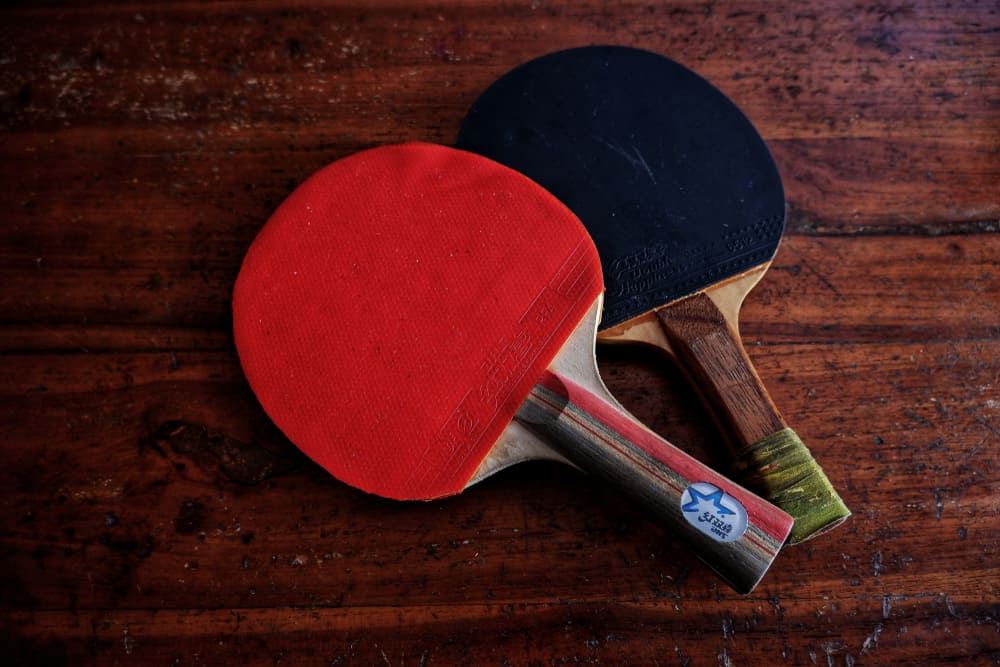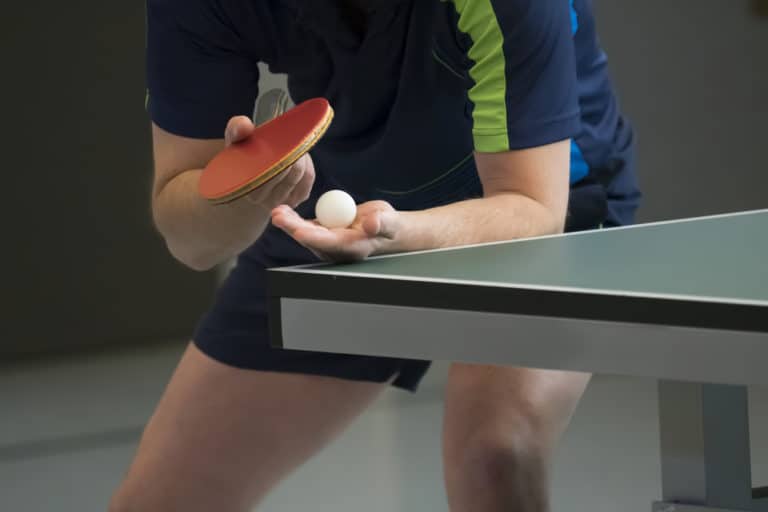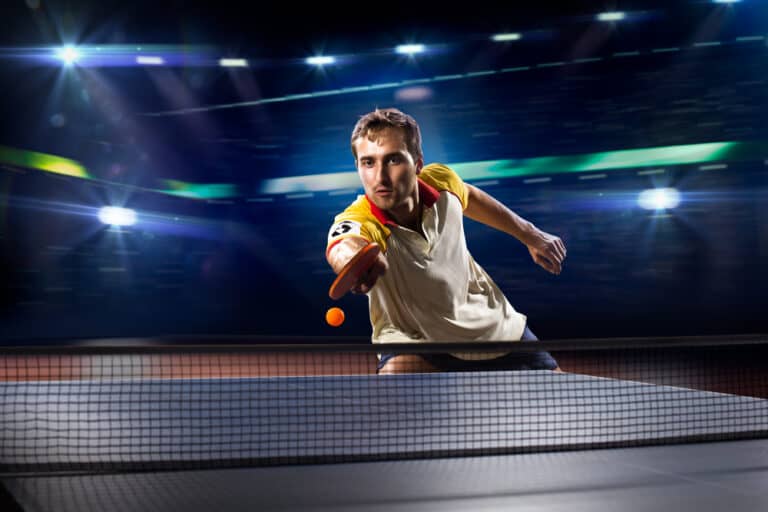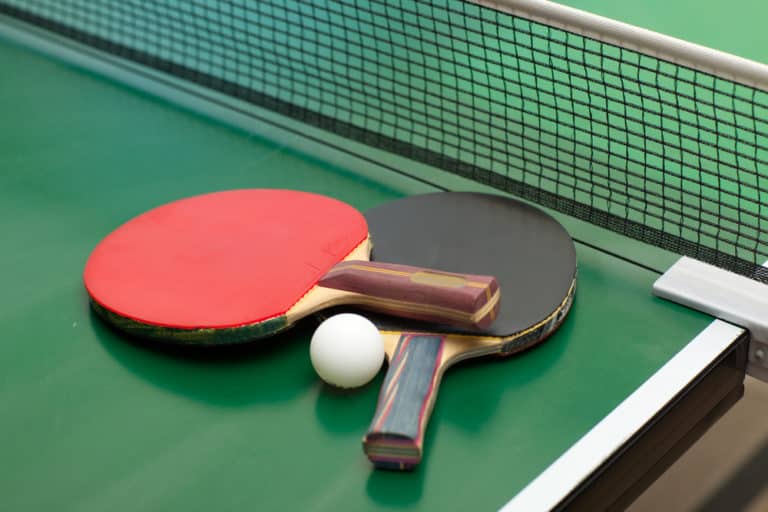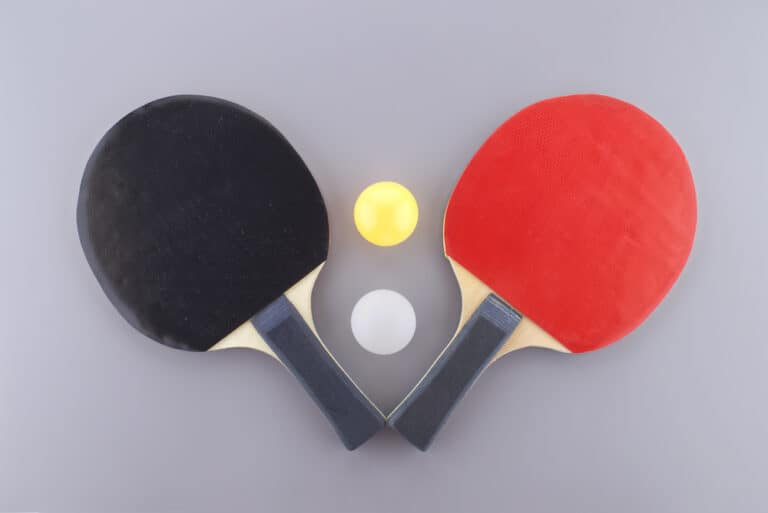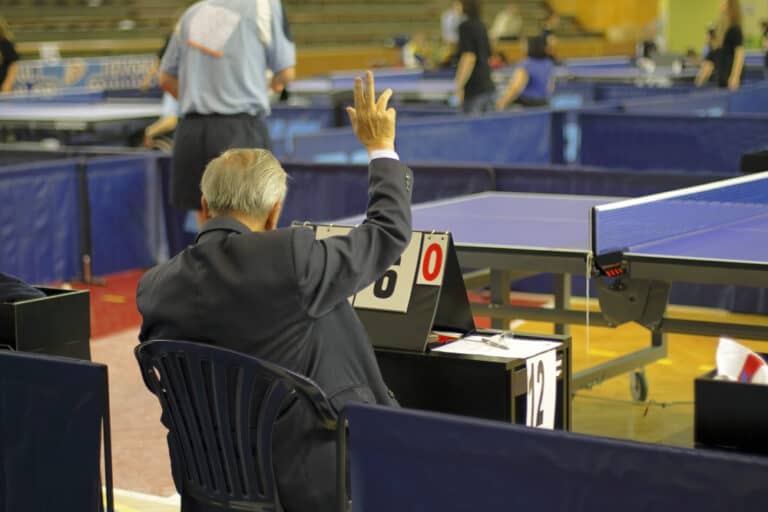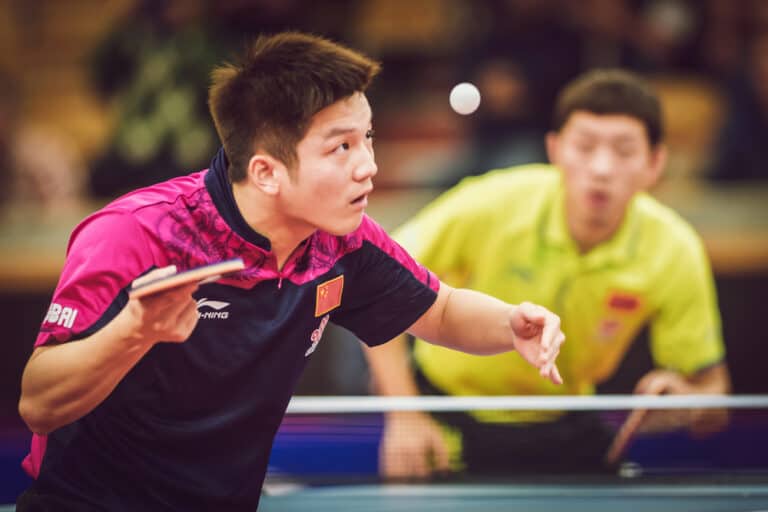Why Is A Table Tennis Bat Red And Black?
Editorial credit: Adi purnatama / Shutterstock.com
Back in the days when I learned how to play table tennis, our bats were the same color on both sides. We could buy bats in a variety of colors, but the 2 sides would always be the same. However, times changed and so did table tennis bats. Since 1986 table tennis bats became red on one side and black on the other. This has always intrigued me, so I set about finding out why.
The 2 sides of a table tennis bat have different colors to allow players and spectators to see which side of the bat is being used. The black side of the bat has grippier rubber for more spin and the red side is harder for more speed.
Let’s take a closer look at exactly why table tennis bats have different colors on the two sides and what difference it makes to the way that you play table tennis.
Why Table Tennis Rackets Are Red And Black In Color?
The reason why the two sides of a table tennis bat are different colors is to help both players and the audience easily see which side of the bat has the grippier rubber and which side is relatively less grippy.
The previous tournament regulations stated that the colors needed to be red and black, but more recently those regulations were updated to allow the “red” side of the bat to be different colors, but one side of the bat must always be black. The color that is on the reverse side of the bat must be a color that can be easily distinguished from black at a glance.
The grippier rubber is able to create more spin on the ball when playing shots. A player is permitted to examine his/her opponent’s bat before the start of the game to see which color is grippier even though in most cases it is the black side that is grippier.
What Is The Difference Between Black And Red Rubber?
The vast majority of table tennis bats use grippier rubber for the black side of the bat and less grippy rubber for the red side of the bat.
Besides being less grippy, the red side of the bat tends to be harder which allows a player to hit the ball faster and with less spin. Conversely, the black side of the bat tends to be softer which, when combined with sticky rubber, allows a player to create more spin.
The majority of western professionals tend to use red rubber on their forehand and black rubber on their backhand. This allows them to hit the ball faster on the forehand than they normally would.
The top Chinese players, on the other hand, use sticky black rubber on their forehands. This is why you see so much forehand topspin from Chinese players.
Is There Any Difference Between The Black And Red Sides Of A Table Tennis Bat?
When a player uses a table tennis bat that has grippy rubber, the amount of spin they can create is immense. If both sides of the bat have the same color and one side has more grip it is impossible for an opponent to properly read whether the ball is being hit using the side of the bat that generates spin or not.
I remember this from when I played table tennis in high school. The bat that I used when I was learning the penhold grip was old and somewhat worn out. Both sides were the same color and originally had identical rubber. However, when I was using the bat one side was more worn out and less grippy than the other. I noticed that my opponents had no way of being able to tell if I was using the grippy side or not.
That is why the ITTF mandated using bats with one side red and the other black and the black side is the grippier rubber.
The rule change that mandated the different color rubber was brought in during the 1986 season and remained unchanged until 2021 when it was amended to allow different colors to be used in place of the red rubber.
Have More Colors Been Added To The Black And Red Color Rule?
After three and a half decades of having table tennis bats limited to being red and black, the ITTF modernized their rule in October 2021 and allowed four additional colors to be used for the rubber on table tennis bats. These new colors were blue, green, pink, and purple. However, these new colors could only be used on the side of the table tennis bat that had previously been red.
This change has allowed players to personalize and optimize their table tennis bats. It has also given the table tennis bat manufacturers a wider variety of products to offer their customers.
To maintain some degree of consistency for the players and spectators, however, one side of the table tennis bat needs to remain black. In addition, the black side of the table tennis bat must be the side with the grippier rubber that can generate more spin – irrespective of what color the reverse side of the bat is. That way everyone could easily see when a player was using the grippy side of their bat.
Are The Effects Of The Rubbers The Same
I have heard several casual players argue that the black and red rubber of a table tennis bat is effectively the same and that the difference is nothing more than visual/cosmetic. My experience with the two rubbers on a table tennis bat is completely different.
However, the longer you play table tennis the more you will pick up on the difference in feel between the two sides of the bat. The harder red rubber produces more speed and the softer black rubber enables you to play with more spin.
Many casual players don’t use much speed or spin when playing and hence don’t notice how the different sides of the bat affect the ball.
With that said, the difference is becoming more subtle in top-end bats as the technological advances in the dye used to color the rubber reduces the effect the dye has on the rubber.
What Are The Two Sides Of A Table Tennis Racket Called?
In general, the two sides of a table tennis bat are called the forehand side and the backhand side. This refers to how you hold the bat while playing because if you spin the bat in your hand, what was the forehand side becomes the backhand side and vice versa.
If you are playing with a tournament-approved racket, the two sides will be called the red side and the black side. In this instance, the two sides will still be referred to by their colors even if you spin the bat in your hand.
Newer models of tournament-approved bats can have different colors instead of red rubber. Here we refer to the side of the bat by the color rubber it has, so it will be the black side and the green/blue/pink side by way of example.
When I was playing as a junior, the bats we used were the same color on both sides, but the rubber on one side had raised bumps. We called the two sides of our bat the pips side and the smooth side.
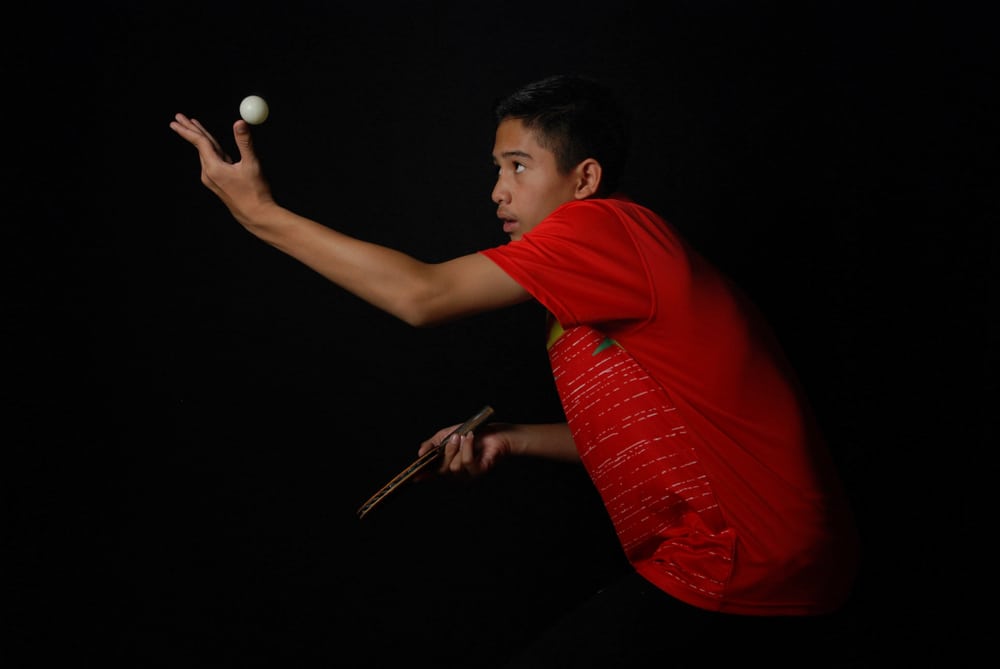
Is Having The Same Rubber On Both Forehand And Backhand Side Recommended In Table Tennis
For beginner table tennis players it will be an advantage to have the same rubber on both sides of a table tennis bat. The reason is that it gives a greater feeling of consistency between the forehand and the backhand as the player is new player is building their skills and their eye-to-ball coordination. There are already so many factors about the game for a new player to learn. Having to worry about which side of the bat they are using is something that can wait until later.
If you are a player that likes to play in a fast, offensive way, with fast shots and little spin then it might be worth your while to use the same rubber on both sides of your bat. It will give you a greater feeling of consistency when you play fast shots with both your forehand and backhand.
There are a few higher-level European and American players that use this approach. However, Chinese players all use very sticky soft rubber for the forehand side of their bats to generate lots of topspin.
Are You Allowed To Inspect Your Opponent’s Bat Before A Match
Players are permitted to inspect their opponent’s bat before the start of the game. The reason for this is to be able to inspect the rubber used on each side of the bat for how sticky it is. This allows players to better read the spin that their opponent is giving the ball on each shot.
Having different colored rubber on the two sides of the bat makes it easier for a player to see which side of the bat, and consequently which rubber, is being used for each shot.
When I first saw that players are only allowed to inspect an opponent’s bat before the start of a game, my immediate thought was that professional players could potentially switch to a bat that had different rubber at some stage during the game and gain an advantage. However, the ITTF rules have that one covered as well. A player is not permitted to change their bat for another one during a match unless it gets damaged during play.
Why Do Table Tennis Players Inspect Each Other’s Rackets?
As we have already mentioned, one reason that a player will check his opponent’s bat before the match is to get a feel for how grippy the rubber is on the two sides so that they can better read the amount of spin their opponent is using when playing their shots. However, players check for something else too that is equally important… The blade of the table tennis bat.
The blade of a table tennis bat will fall into one of two main categories and will tell you a lot about your opponent’s general style of play. Players will want to ascertain whether their players are using a wood blade or a carbon blade. Let’s look at each so that you can see what they say about a player using them.
Wood Blade: A wood blade is manufactured from 100% wood. They are also referred to as “Allwood” blades.
The main feature of Allwood blades is that they are relatively slow compared to carbon blades and they give a player more control over the ball. Coaches will always advise beginners to start with an all-wood blade.
If any of your opponents are using wood blades, the chances are more that they are more conservative kinds of players. A more conservative player likes to control the ball more and have a “close to the table” style of play. It is also possible that a wood blade could indicate a more intermediate-level player in a social game. I always only used all-wood blades when I played.
Carbon blade: A carbon blade has a combination of carbon and wood layers. The most common carbon blade available has 5 layers of wood and 2 layers of carbon. The wood and carbon are combined because the wood layers make the blade more robust with a lower risk of cracking if a player accidentally hits the edge of the table with their bat.
Carbon gives the blade extra hardness, thereby increasing the amount of power on your shots but the extra power comes at the cost of having control over the ball.
These days the majority of top-ranked players routinely use carbon blades. If your opponent is using a carbon blade, chances are that he or she likes to play fast and offensive and use a far-from-the-table style of play.
Does A Good Table Tennis Bat Make A Difference?
Top-quality table tennis bats make a massive difference in performance. However, the biggest factor that determines table tennis performance will be the skill level player. When you put a top-quality bat in the hands of a highly skilled player the results will be phenomenal.
However, that same high-performance bat can be a hindrance in the hands of a beginner. Top-quality carbon rackets allow players to play faster shots with a lot more spin. That speed and spin come at the cost of control over the ball meaning that high-performance bats have a much smaller margin for error.
Therefore novice players will make more unforced errors with a high-performance bat than they will if playing with a more forgiving all-wood bat. Only make the step-up to a high-performance carbon blade when your skill level has progressed to the point where you will begin to get the benefit of the bat or else you will actually hinder your progress as a player.
Can A Table Tennis Bat Touch The Table?
In terms of the ITTF rules, a player will only lose a point if they touch the table with their free hand or move the playing surface when touching the table with any other part of their body.
Therefore it is permitted to touch the table with a table tennis bat as long as the table doesn’t move.

